Exploring Learning Theories and Their Relevance to Nursing Practice
VerifiedAdded on 2020/01/21
|10
|2802
|79
Essay
AI Summary
This essay examines the application of various learning theories to nursing practice, emphasizing their importance in healthcare. It begins with an introduction to learning and its significance in nursing, highlighting the evolution of educational psychology. The essay then delves into specific theories, including the Behaviorist Learning Theory, Piaget's Developmental Theory, Bandura's Social Learning Theory, Maslow's hierarchy of needs, and neuropsychology. Each theory is explained with examples of its relevance to nursing, such as using operant conditioning for patient education, applying Piaget's theory to understand dyslexia, and leveraging Bandura's theory to enhance self-efficacy. The essay also touches on the role of emotions and classical conditioning in learning. The conclusion stresses the need for nurses to understand and apply these theories to improve patient care, education, and staff training, emphasizing that while in-depth knowledge isn't always necessary, guidance and training are essential. This essay is a valuable resource for nursing students and professionals seeking to enhance their understanding of learning theories and their practical applications within the healthcare setting.
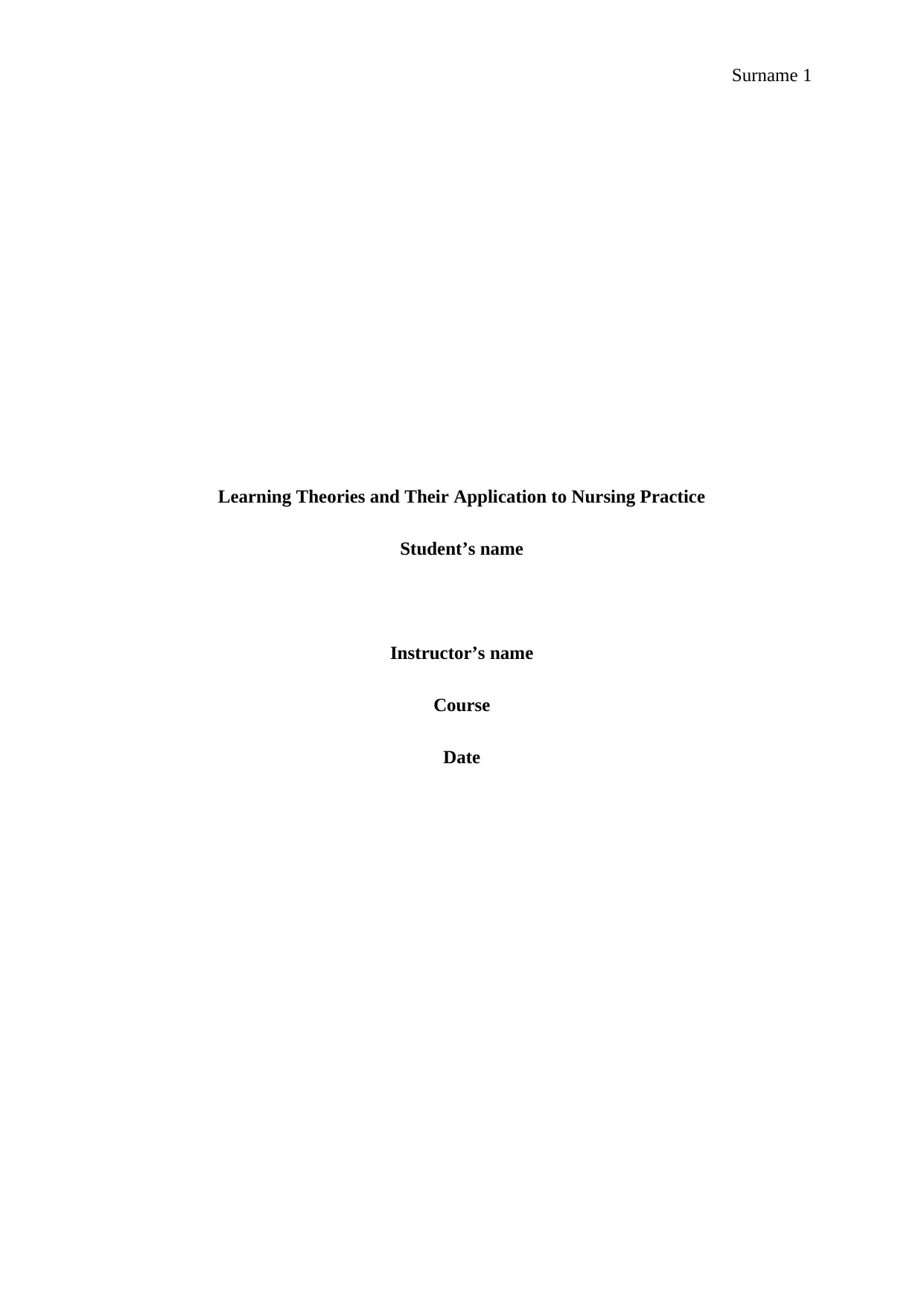
Surname 1
Learning Theories and Their Application to Nursing Practice
Student’s name
Instructor’s name
Course
Date
Learning Theories and Their Application to Nursing Practice
Student’s name
Instructor’s name
Course
Date
Paraphrase This Document
Need a fresh take? Get an instant paraphrase of this document with our AI Paraphraser
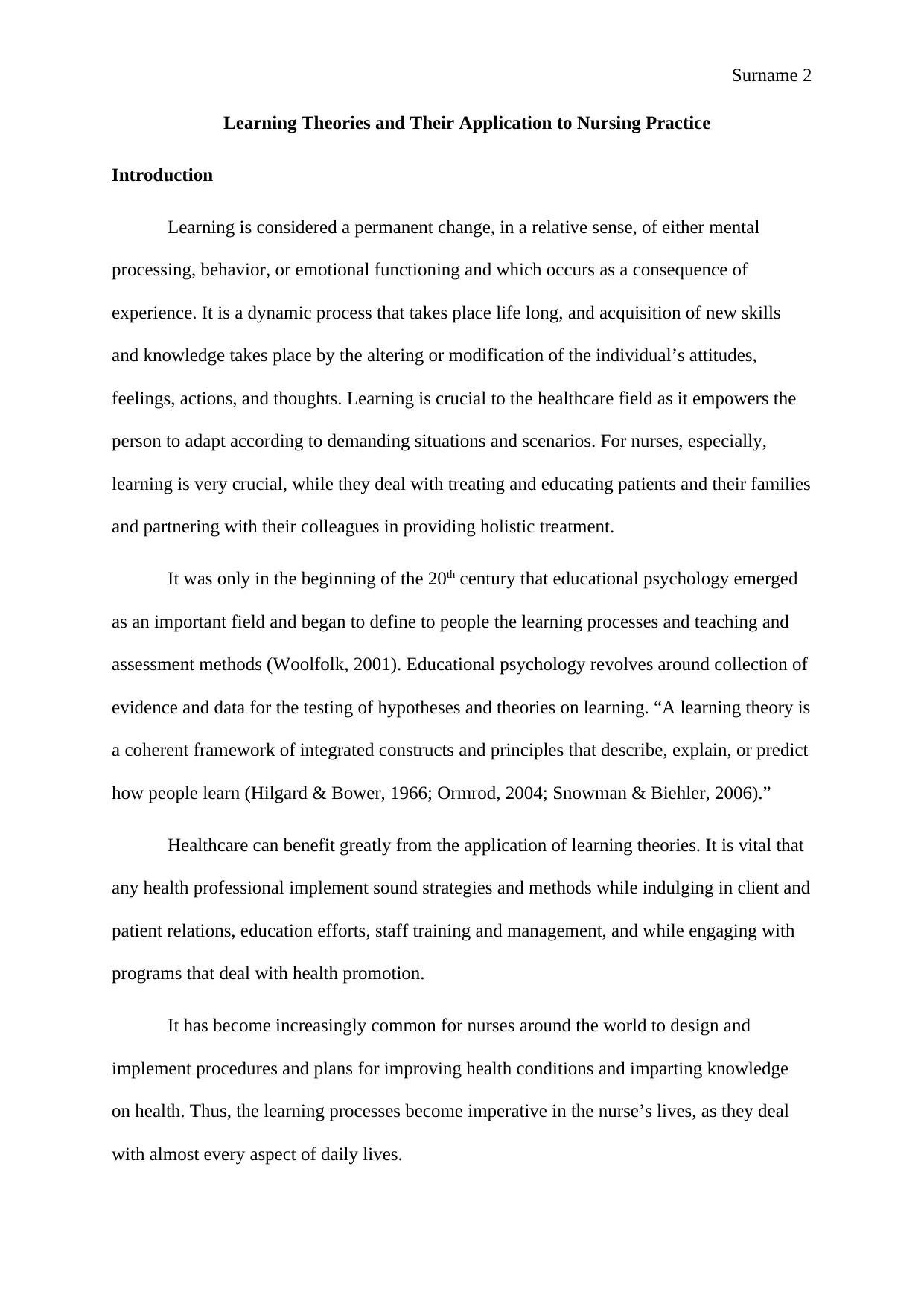
Surname 2
Learning Theories and Their Application to Nursing Practice
Introduction
Learning is considered a permanent change, in a relative sense, of either mental
processing, behavior, or emotional functioning and which occurs as a consequence of
experience. It is a dynamic process that takes place life long, and acquisition of new skills
and knowledge takes place by the altering or modification of the individual’s attitudes,
feelings, actions, and thoughts. Learning is crucial to the healthcare field as it empowers the
person to adapt according to demanding situations and scenarios. For nurses, especially,
learning is very crucial, while they deal with treating and educating patients and their families
and partnering with their colleagues in providing holistic treatment.
It was only in the beginning of the 20th century that educational psychology emerged
as an important field and began to define to people the learning processes and teaching and
assessment methods (Woolfolk, 2001). Educational psychology revolves around collection of
evidence and data for the testing of hypotheses and theories on learning. “A learning theory is
a coherent framework of integrated constructs and principles that describe, explain, or predict
how people learn (Hilgard & Bower, 1966; Ormrod, 2004; Snowman & Biehler, 2006).”
Healthcare can benefit greatly from the application of learning theories. It is vital that
any health professional implement sound strategies and methods while indulging in client and
patient relations, education efforts, staff training and management, and while engaging with
programs that deal with health promotion.
It has become increasingly common for nurses around the world to design and
implement procedures and plans for improving health conditions and imparting knowledge
on health. Thus, the learning processes become imperative in the nurse’s lives, as they deal
with almost every aspect of daily lives.
Learning Theories and Their Application to Nursing Practice
Introduction
Learning is considered a permanent change, in a relative sense, of either mental
processing, behavior, or emotional functioning and which occurs as a consequence of
experience. It is a dynamic process that takes place life long, and acquisition of new skills
and knowledge takes place by the altering or modification of the individual’s attitudes,
feelings, actions, and thoughts. Learning is crucial to the healthcare field as it empowers the
person to adapt according to demanding situations and scenarios. For nurses, especially,
learning is very crucial, while they deal with treating and educating patients and their families
and partnering with their colleagues in providing holistic treatment.
It was only in the beginning of the 20th century that educational psychology emerged
as an important field and began to define to people the learning processes and teaching and
assessment methods (Woolfolk, 2001). Educational psychology revolves around collection of
evidence and data for the testing of hypotheses and theories on learning. “A learning theory is
a coherent framework of integrated constructs and principles that describe, explain, or predict
how people learn (Hilgard & Bower, 1966; Ormrod, 2004; Snowman & Biehler, 2006).”
Healthcare can benefit greatly from the application of learning theories. It is vital that
any health professional implement sound strategies and methods while indulging in client and
patient relations, education efforts, staff training and management, and while engaging with
programs that deal with health promotion.
It has become increasingly common for nurses around the world to design and
implement procedures and plans for improving health conditions and imparting knowledge
on health. Thus, the learning processes become imperative in the nurse’s lives, as they deal
with almost every aspect of daily lives.
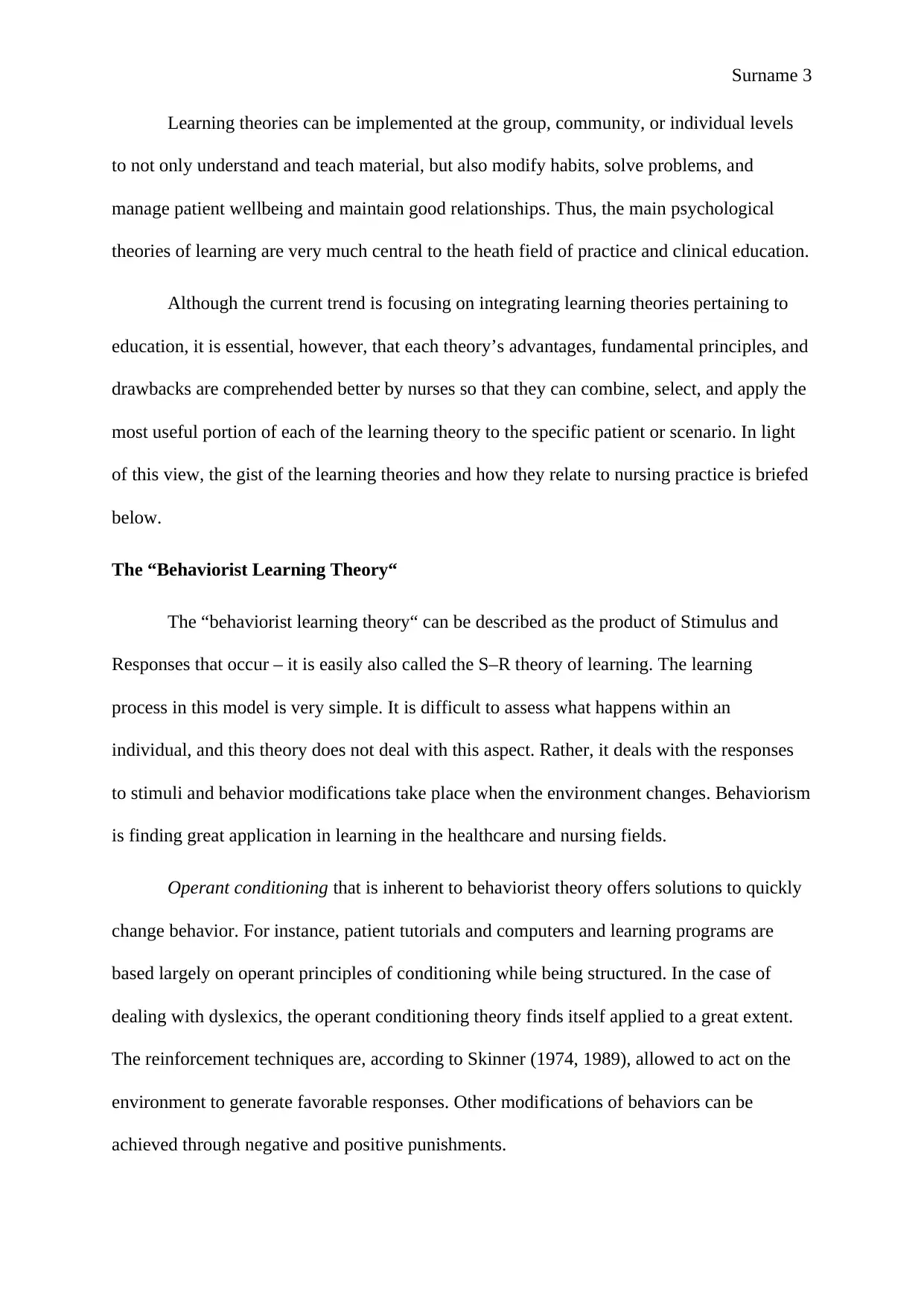
Surname 3
Learning theories can be implemented at the group, community, or individual levels
to not only understand and teach material, but also modify habits, solve problems, and
manage patient wellbeing and maintain good relationships. Thus, the main psychological
theories of learning are very much central to the heath field of practice and clinical education.
Although the current trend is focusing on integrating learning theories pertaining to
education, it is essential, however, that each theory’s advantages, fundamental principles, and
drawbacks are comprehended better by nurses so that they can combine, select, and apply the
most useful portion of each of the learning theory to the specific patient or scenario. In light
of this view, the gist of the learning theories and how they relate to nursing practice is briefed
below.
The “Behaviorist Learning Theory“
The “behaviorist learning theory“ can be described as the product of Stimulus and
Responses that occur – it is easily also called the S–R theory of learning. The learning
process in this model is very simple. It is difficult to assess what happens within an
individual, and this theory does not deal with this aspect. Rather, it deals with the responses
to stimuli and behavior modifications take place when the environment changes. Behaviorism
is finding great application in learning in the healthcare and nursing fields.
Operant conditioning that is inherent to behaviorist theory offers solutions to quickly
change behavior. For instance, patient tutorials and computers and learning programs are
based largely on operant principles of conditioning while being structured. In the case of
dealing with dyslexics, the operant conditioning theory finds itself applied to a great extent.
The reinforcement techniques are, according to Skinner (1974, 1989), allowed to act on the
environment to generate favorable responses. Other modifications of behaviors can be
achieved through negative and positive punishments.
Learning theories can be implemented at the group, community, or individual levels
to not only understand and teach material, but also modify habits, solve problems, and
manage patient wellbeing and maintain good relationships. Thus, the main psychological
theories of learning are very much central to the heath field of practice and clinical education.
Although the current trend is focusing on integrating learning theories pertaining to
education, it is essential, however, that each theory’s advantages, fundamental principles, and
drawbacks are comprehended better by nurses so that they can combine, select, and apply the
most useful portion of each of the learning theory to the specific patient or scenario. In light
of this view, the gist of the learning theories and how they relate to nursing practice is briefed
below.
The “Behaviorist Learning Theory“
The “behaviorist learning theory“ can be described as the product of Stimulus and
Responses that occur – it is easily also called the S–R theory of learning. The learning
process in this model is very simple. It is difficult to assess what happens within an
individual, and this theory does not deal with this aspect. Rather, it deals with the responses
to stimuli and behavior modifications take place when the environment changes. Behaviorism
is finding great application in learning in the healthcare and nursing fields.
Operant conditioning that is inherent to behaviorist theory offers solutions to quickly
change behavior. For instance, patient tutorials and computers and learning programs are
based largely on operant principles of conditioning while being structured. In the case of
dealing with dyslexics, the operant conditioning theory finds itself applied to a great extent.
The reinforcement techniques are, according to Skinner (1974, 1989), allowed to act on the
environment to generate favorable responses. Other modifications of behaviors can be
achieved through negative and positive punishments.
⊘ This is a preview!⊘
Do you want full access?
Subscribe today to unlock all pages.

Trusted by 1+ million students worldwide
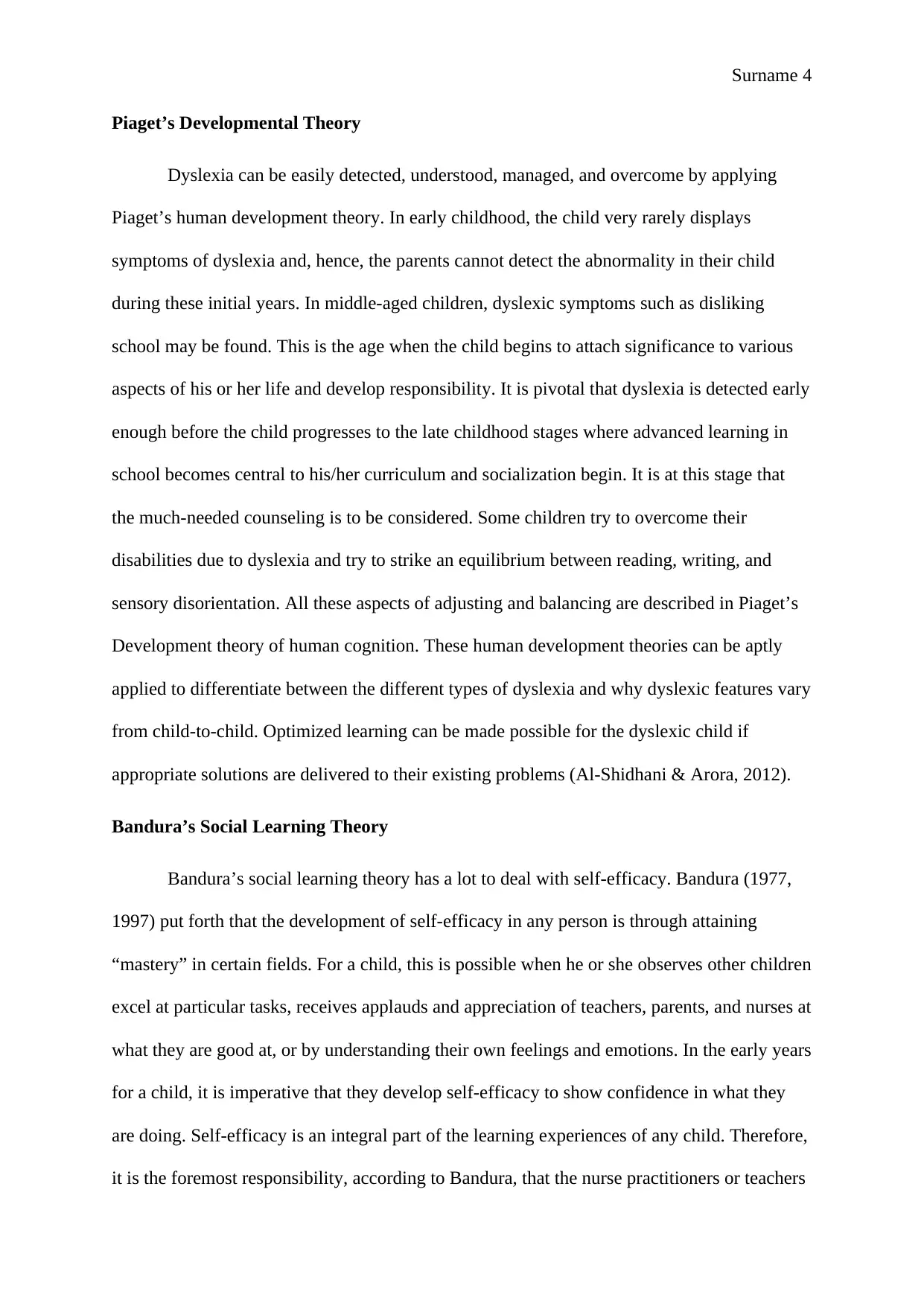
Surname 4
Piaget’s Developmental Theory
Dyslexia can be easily detected, understood, managed, and overcome by applying
Piaget’s human development theory. In early childhood, the child very rarely displays
symptoms of dyslexia and, hence, the parents cannot detect the abnormality in their child
during these initial years. In middle-aged children, dyslexic symptoms such as disliking
school may be found. This is the age when the child begins to attach significance to various
aspects of his or her life and develop responsibility. It is pivotal that dyslexia is detected early
enough before the child progresses to the late childhood stages where advanced learning in
school becomes central to his/her curriculum and socialization begin. It is at this stage that
the much-needed counseling is to be considered. Some children try to overcome their
disabilities due to dyslexia and try to strike an equilibrium between reading, writing, and
sensory disorientation. All these aspects of adjusting and balancing are described in Piaget’s
Development theory of human cognition. These human development theories can be aptly
applied to differentiate between the different types of dyslexia and why dyslexic features vary
from child-to-child. Optimized learning can be made possible for the dyslexic child if
appropriate solutions are delivered to their existing problems (Al-Shidhani & Arora, 2012).
Bandura’s Social Learning Theory
Bandura’s social learning theory has a lot to deal with self-efficacy. Bandura (1977,
1997) put forth that the development of self-efficacy in any person is through attaining
“mastery” in certain fields. For a child, this is possible when he or she observes other children
excel at particular tasks, receives applauds and appreciation of teachers, parents, and nurses at
what they are good at, or by understanding their own feelings and emotions. In the early years
for a child, it is imperative that they develop self-efficacy to show confidence in what they
are doing. Self-efficacy is an integral part of the learning experiences of any child. Therefore,
it is the foremost responsibility, according to Bandura, that the nurse practitioners or teachers
Piaget’s Developmental Theory
Dyslexia can be easily detected, understood, managed, and overcome by applying
Piaget’s human development theory. In early childhood, the child very rarely displays
symptoms of dyslexia and, hence, the parents cannot detect the abnormality in their child
during these initial years. In middle-aged children, dyslexic symptoms such as disliking
school may be found. This is the age when the child begins to attach significance to various
aspects of his or her life and develop responsibility. It is pivotal that dyslexia is detected early
enough before the child progresses to the late childhood stages where advanced learning in
school becomes central to his/her curriculum and socialization begin. It is at this stage that
the much-needed counseling is to be considered. Some children try to overcome their
disabilities due to dyslexia and try to strike an equilibrium between reading, writing, and
sensory disorientation. All these aspects of adjusting and balancing are described in Piaget’s
Development theory of human cognition. These human development theories can be aptly
applied to differentiate between the different types of dyslexia and why dyslexic features vary
from child-to-child. Optimized learning can be made possible for the dyslexic child if
appropriate solutions are delivered to their existing problems (Al-Shidhani & Arora, 2012).
Bandura’s Social Learning Theory
Bandura’s social learning theory has a lot to deal with self-efficacy. Bandura (1977,
1997) put forth that the development of self-efficacy in any person is through attaining
“mastery” in certain fields. For a child, this is possible when he or she observes other children
excel at particular tasks, receives applauds and appreciation of teachers, parents, and nurses at
what they are good at, or by understanding their own feelings and emotions. In the early years
for a child, it is imperative that they develop self-efficacy to show confidence in what they
are doing. Self-efficacy is an integral part of the learning experiences of any child. Therefore,
it is the foremost responsibility, according to Bandura, that the nurse practitioners or teachers
Paraphrase This Document
Need a fresh take? Get an instant paraphrase of this document with our AI Paraphraser
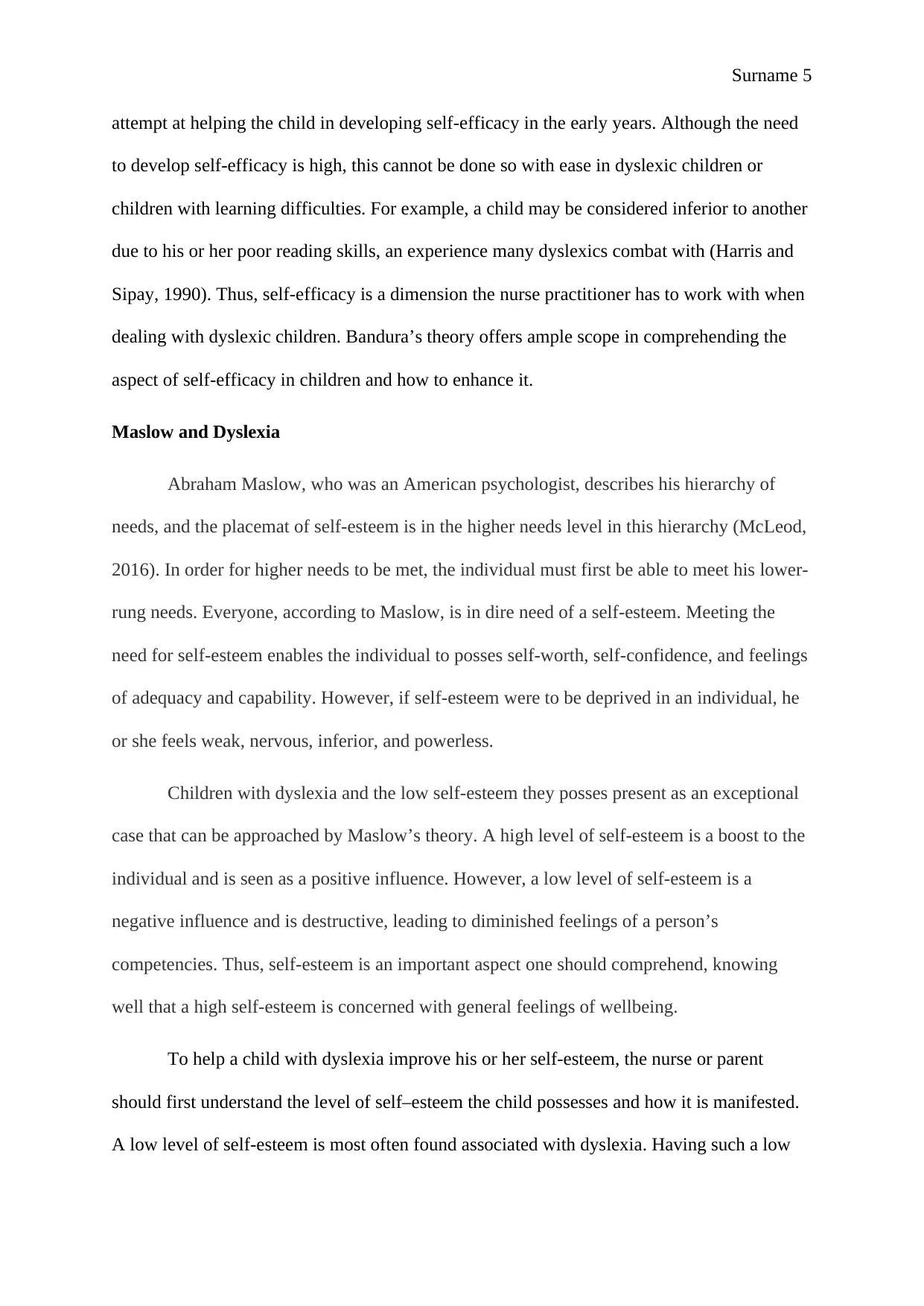
Surname 5
attempt at helping the child in developing self-efficacy in the early years. Although the need
to develop self-efficacy is high, this cannot be done so with ease in dyslexic children or
children with learning difficulties. For example, a child may be considered inferior to another
due to his or her poor reading skills, an experience many dyslexics combat with (Harris and
Sipay, 1990). Thus, self-efficacy is a dimension the nurse practitioner has to work with when
dealing with dyslexic children. Bandura’s theory offers ample scope in comprehending the
aspect of self-efficacy in children and how to enhance it.
Maslow and Dyslexia
Abraham Maslow, who was an American psychologist, describes his hierarchy of
needs, and the placemat of self-esteem is in the higher needs level in this hierarchy (McLeod,
2016). In order for higher needs to be met, the individual must first be able to meet his lower-
rung needs. Everyone, according to Maslow, is in dire need of a self-esteem. Meeting the
need for self-esteem enables the individual to posses self-worth, self-confidence, and feelings
of adequacy and capability. However, if self-esteem were to be deprived in an individual, he
or she feels weak, nervous, inferior, and powerless.
Children with dyslexia and the low self-esteem they posses present as an exceptional
case that can be approached by Maslow’s theory. A high level of self-esteem is a boost to the
individual and is seen as a positive influence. However, a low level of self-esteem is a
negative influence and is destructive, leading to diminished feelings of a person’s
competencies. Thus, self-esteem is an important aspect one should comprehend, knowing
well that a high self-esteem is concerned with general feelings of wellbeing.
To help a child with dyslexia improve his or her self-esteem, the nurse or parent
should first understand the level of self–esteem the child possesses and how it is manifested.
A low level of self-esteem is most often found associated with dyslexia. Having such a low
attempt at helping the child in developing self-efficacy in the early years. Although the need
to develop self-efficacy is high, this cannot be done so with ease in dyslexic children or
children with learning difficulties. For example, a child may be considered inferior to another
due to his or her poor reading skills, an experience many dyslexics combat with (Harris and
Sipay, 1990). Thus, self-efficacy is a dimension the nurse practitioner has to work with when
dealing with dyslexic children. Bandura’s theory offers ample scope in comprehending the
aspect of self-efficacy in children and how to enhance it.
Maslow and Dyslexia
Abraham Maslow, who was an American psychologist, describes his hierarchy of
needs, and the placemat of self-esteem is in the higher needs level in this hierarchy (McLeod,
2016). In order for higher needs to be met, the individual must first be able to meet his lower-
rung needs. Everyone, according to Maslow, is in dire need of a self-esteem. Meeting the
need for self-esteem enables the individual to posses self-worth, self-confidence, and feelings
of adequacy and capability. However, if self-esteem were to be deprived in an individual, he
or she feels weak, nervous, inferior, and powerless.
Children with dyslexia and the low self-esteem they posses present as an exceptional
case that can be approached by Maslow’s theory. A high level of self-esteem is a boost to the
individual and is seen as a positive influence. However, a low level of self-esteem is a
negative influence and is destructive, leading to diminished feelings of a person’s
competencies. Thus, self-esteem is an important aspect one should comprehend, knowing
well that a high self-esteem is concerned with general feelings of wellbeing.
To help a child with dyslexia improve his or her self-esteem, the nurse or parent
should first understand the level of self–esteem the child possesses and how it is manifested.
A low level of self-esteem is most often found associated with dyslexia. Having such a low
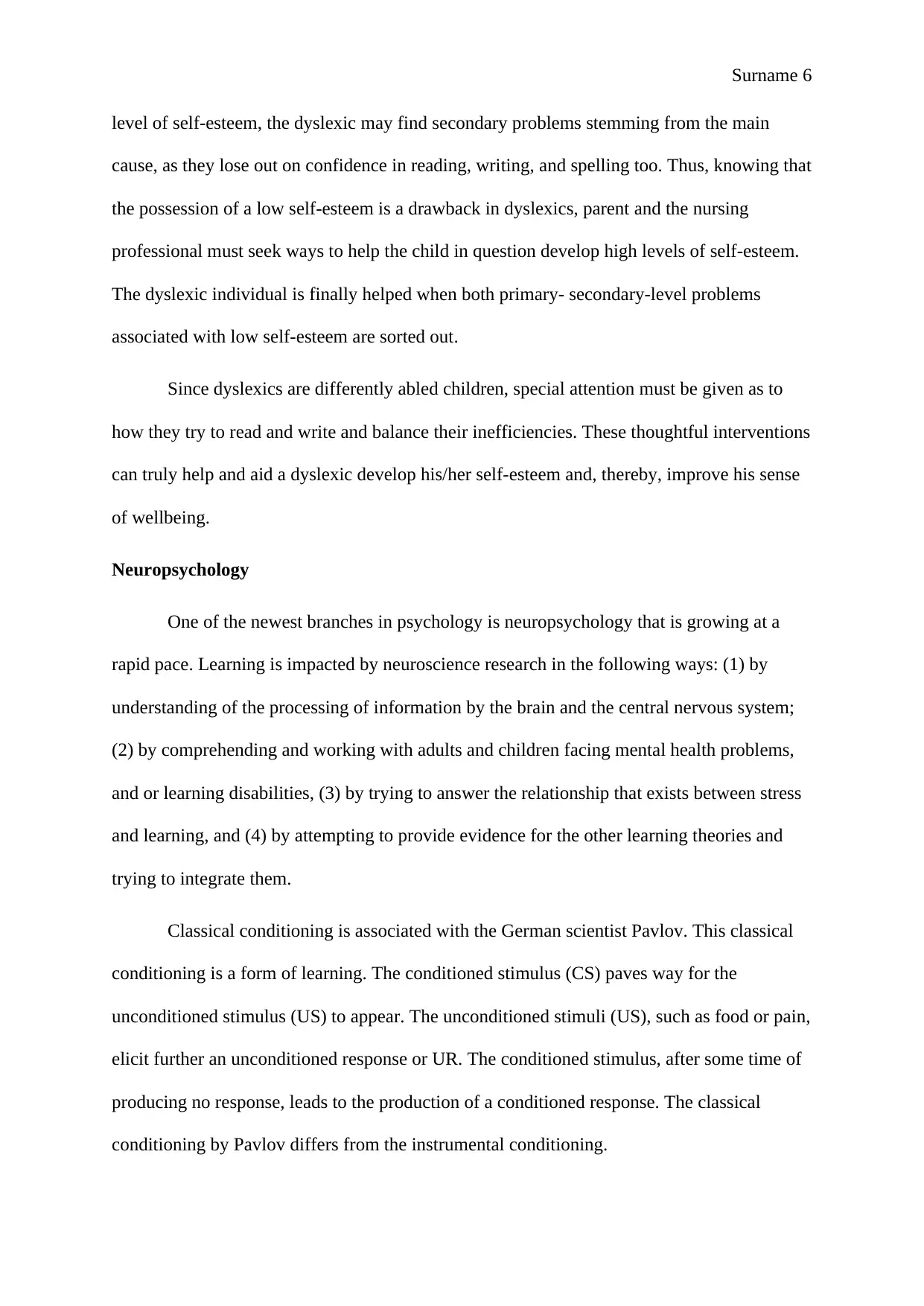
Surname 6
level of self-esteem, the dyslexic may find secondary problems stemming from the main
cause, as they lose out on confidence in reading, writing, and spelling too. Thus, knowing that
the possession of a low self-esteem is a drawback in dyslexics, parent and the nursing
professional must seek ways to help the child in question develop high levels of self-esteem.
The dyslexic individual is finally helped when both primary- secondary-level problems
associated with low self-esteem are sorted out.
Since dyslexics are differently abled children, special attention must be given as to
how they try to read and write and balance their inefficiencies. These thoughtful interventions
can truly help and aid a dyslexic develop his/her self-esteem and, thereby, improve his sense
of wellbeing.
Neuropsychology
One of the newest branches in psychology is neuropsychology that is growing at a
rapid pace. Learning is impacted by neuroscience research in the following ways: (1) by
understanding of the processing of information by the brain and the central nervous system;
(2) by comprehending and working with adults and children facing mental health problems,
and or learning disabilities, (3) by trying to answer the relationship that exists between stress
and learning, and (4) by attempting to provide evidence for the other learning theories and
trying to integrate them.
Classical conditioning is associated with the German scientist Pavlov. This classical
conditioning is a form of learning. The conditioned stimulus (CS) paves way for the
unconditioned stimulus (US) to appear. The unconditioned stimuli (US), such as food or pain,
elicit further an unconditioned response or UR. The conditioned stimulus, after some time of
producing no response, leads to the production of a conditioned response. The classical
conditioning by Pavlov differs from the instrumental conditioning.
level of self-esteem, the dyslexic may find secondary problems stemming from the main
cause, as they lose out on confidence in reading, writing, and spelling too. Thus, knowing that
the possession of a low self-esteem is a drawback in dyslexics, parent and the nursing
professional must seek ways to help the child in question develop high levels of self-esteem.
The dyslexic individual is finally helped when both primary- secondary-level problems
associated with low self-esteem are sorted out.
Since dyslexics are differently abled children, special attention must be given as to
how they try to read and write and balance their inefficiencies. These thoughtful interventions
can truly help and aid a dyslexic develop his/her self-esteem and, thereby, improve his sense
of wellbeing.
Neuropsychology
One of the newest branches in psychology is neuropsychology that is growing at a
rapid pace. Learning is impacted by neuroscience research in the following ways: (1) by
understanding of the processing of information by the brain and the central nervous system;
(2) by comprehending and working with adults and children facing mental health problems,
and or learning disabilities, (3) by trying to answer the relationship that exists between stress
and learning, and (4) by attempting to provide evidence for the other learning theories and
trying to integrate them.
Classical conditioning is associated with the German scientist Pavlov. This classical
conditioning is a form of learning. The conditioned stimulus (CS) paves way for the
unconditioned stimulus (US) to appear. The unconditioned stimuli (US), such as food or pain,
elicit further an unconditioned response or UR. The conditioned stimulus, after some time of
producing no response, leads to the production of a conditioned response. The classical
conditioning by Pavlov differs from the instrumental conditioning.
⊘ This is a preview!⊘
Do you want full access?
Subscribe today to unlock all pages.

Trusted by 1+ million students worldwide
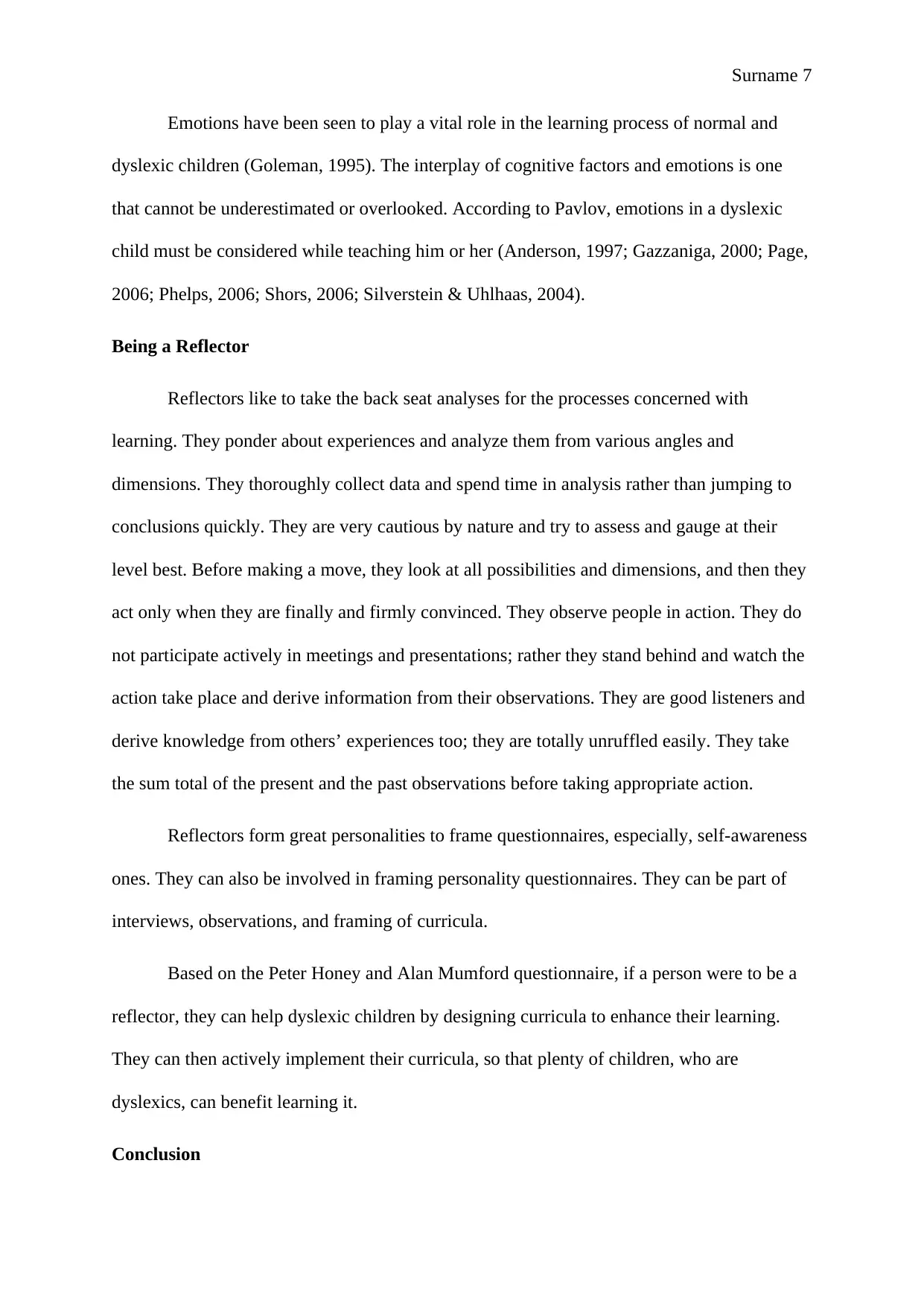
Surname 7
Emotions have been seen to play a vital role in the learning process of normal and
dyslexic children (Goleman, 1995). The interplay of cognitive factors and emotions is one
that cannot be underestimated or overlooked. According to Pavlov, emotions in a dyslexic
child must be considered while teaching him or her (Anderson, 1997; Gazzaniga, 2000; Page,
2006; Phelps, 2006; Shors, 2006; Silverstein & Uhlhaas, 2004).
Being a Reflector
Reflectors like to take the back seat analyses for the processes concerned with
learning. They ponder about experiences and analyze them from various angles and
dimensions. They thoroughly collect data and spend time in analysis rather than jumping to
conclusions quickly. They are very cautious by nature and try to assess and gauge at their
level best. Before making a move, they look at all possibilities and dimensions, and then they
act only when they are finally and firmly convinced. They observe people in action. They do
not participate actively in meetings and presentations; rather they stand behind and watch the
action take place and derive information from their observations. They are good listeners and
derive knowledge from others’ experiences too; they are totally unruffled easily. They take
the sum total of the present and the past observations before taking appropriate action.
Reflectors form great personalities to frame questionnaires, especially, self-awareness
ones. They can also be involved in framing personality questionnaires. They can be part of
interviews, observations, and framing of curricula.
Based on the Peter Honey and Alan Mumford questionnaire, if a person were to be a
reflector, they can help dyslexic children by designing curricula to enhance their learning.
They can then actively implement their curricula, so that plenty of children, who are
dyslexics, can benefit learning it.
Conclusion
Emotions have been seen to play a vital role in the learning process of normal and
dyslexic children (Goleman, 1995). The interplay of cognitive factors and emotions is one
that cannot be underestimated or overlooked. According to Pavlov, emotions in a dyslexic
child must be considered while teaching him or her (Anderson, 1997; Gazzaniga, 2000; Page,
2006; Phelps, 2006; Shors, 2006; Silverstein & Uhlhaas, 2004).
Being a Reflector
Reflectors like to take the back seat analyses for the processes concerned with
learning. They ponder about experiences and analyze them from various angles and
dimensions. They thoroughly collect data and spend time in analysis rather than jumping to
conclusions quickly. They are very cautious by nature and try to assess and gauge at their
level best. Before making a move, they look at all possibilities and dimensions, and then they
act only when they are finally and firmly convinced. They observe people in action. They do
not participate actively in meetings and presentations; rather they stand behind and watch the
action take place and derive information from their observations. They are good listeners and
derive knowledge from others’ experiences too; they are totally unruffled easily. They take
the sum total of the present and the past observations before taking appropriate action.
Reflectors form great personalities to frame questionnaires, especially, self-awareness
ones. They can also be involved in framing personality questionnaires. They can be part of
interviews, observations, and framing of curricula.
Based on the Peter Honey and Alan Mumford questionnaire, if a person were to be a
reflector, they can help dyslexic children by designing curricula to enhance their learning.
They can then actively implement their curricula, so that plenty of children, who are
dyslexics, can benefit learning it.
Conclusion
Paraphrase This Document
Need a fresh take? Get an instant paraphrase of this document with our AI Paraphraser
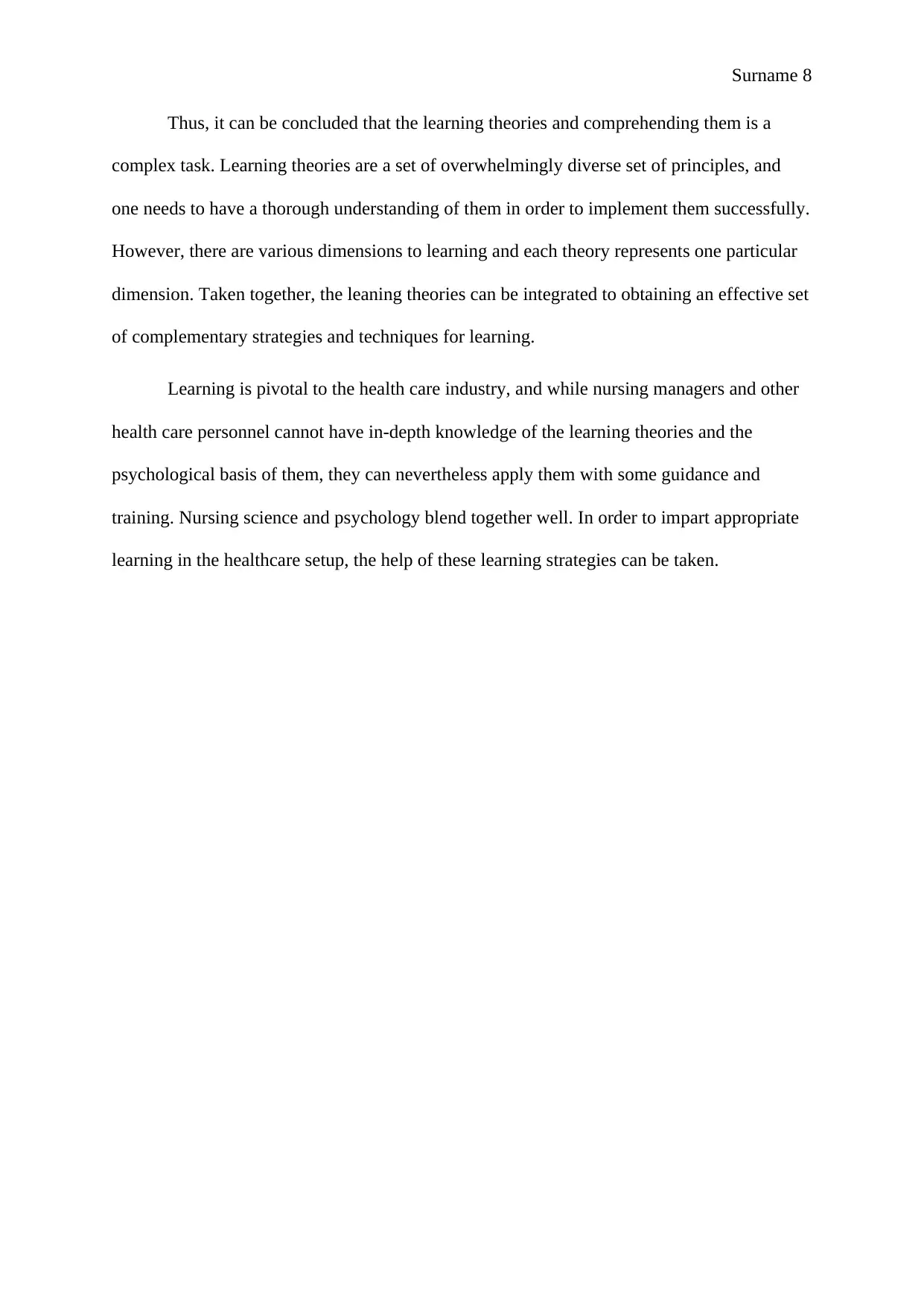
Surname 8
Thus, it can be concluded that the learning theories and comprehending them is a
complex task. Learning theories are a set of overwhelmingly diverse set of principles, and
one needs to have a thorough understanding of them in order to implement them successfully.
However, there are various dimensions to learning and each theory represents one particular
dimension. Taken together, the leaning theories can be integrated to obtaining an effective set
of complementary strategies and techniques for learning.
Learning is pivotal to the health care industry, and while nursing managers and other
health care personnel cannot have in-depth knowledge of the learning theories and the
psychological basis of them, they can nevertheless apply them with some guidance and
training. Nursing science and psychology blend together well. In order to impart appropriate
learning in the healthcare setup, the help of these learning strategies can be taken.
Thus, it can be concluded that the learning theories and comprehending them is a
complex task. Learning theories are a set of overwhelmingly diverse set of principles, and
one needs to have a thorough understanding of them in order to implement them successfully.
However, there are various dimensions to learning and each theory represents one particular
dimension. Taken together, the leaning theories can be integrated to obtaining an effective set
of complementary strategies and techniques for learning.
Learning is pivotal to the health care industry, and while nursing managers and other
health care personnel cannot have in-depth knowledge of the learning theories and the
psychological basis of them, they can nevertheless apply them with some guidance and
training. Nursing science and psychology blend together well. In order to impart appropriate
learning in the healthcare setup, the help of these learning strategies can be taken.
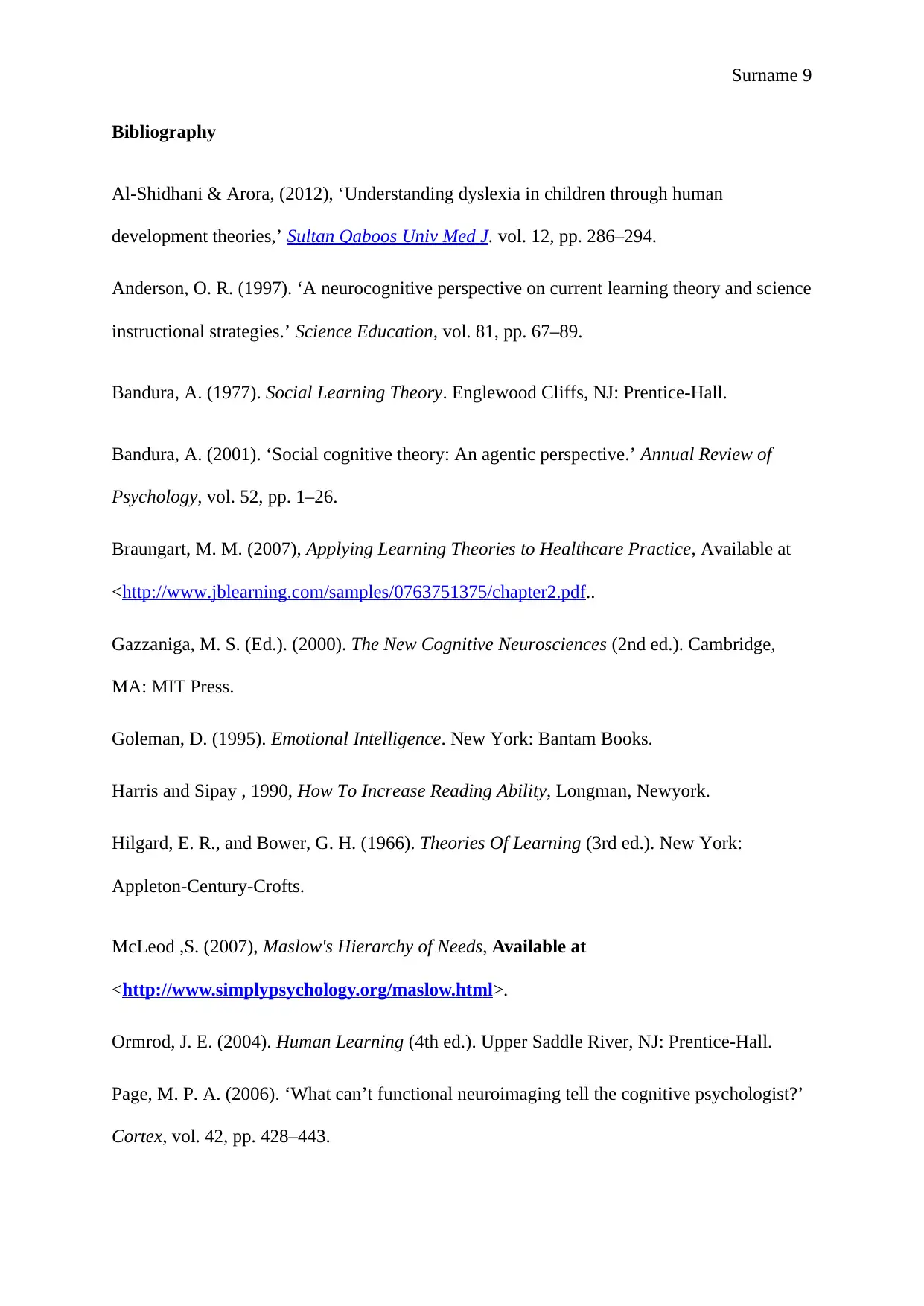
Surname 9
Bibliography
Al-Shidhani & Arora, (2012), ‘Understanding dyslexia in children through human
development theories,’ Sultan Qaboos Univ Med J. vol. 12, pp. 286–294.
Anderson, O. R. (1997). ‘A neurocognitive perspective on current learning theory and science
instructional strategies.’ Science Education, vol. 81, pp. 67–89.
Bandura, A. (1977). Social Learning Theory. Englewood Cliffs, NJ: Prentice-Hall.
Bandura, A. (2001). ‘Social cognitive theory: An agentic perspective.’ Annual Review of
Psychology, vol. 52, pp. 1–26.
Braungart, M. M. (2007), Applying Learning Theories to Healthcare Practice, Available at
<http://www.jblearning.com/samples/0763751375/chapter2.pdf..
Gazzaniga, M. S. (Ed.). (2000). The New Cognitive Neurosciences (2nd ed.). Cambridge,
MA: MIT Press.
Goleman, D. (1995). Emotional Intelligence. New York: Bantam Books.
Harris and Sipay , 1990, How To Increase Reading Ability, Longman, Newyork.
Hilgard, E. R., and Bower, G. H. (1966). Theories Of Learning (3rd ed.). New York:
Appleton-Century-Crofts.
McLeod ,S. (2007), Maslow's Hierarchy of Needs, Available at
<http://www.simplypsychology.org/maslow.html>.
Ormrod, J. E. (2004). Human Learning (4th ed.). Upper Saddle River, NJ: Prentice-Hall.
Page, M. P. A. (2006). ‘What can’t functional neuroimaging tell the cognitive psychologist?’
Cortex, vol. 42, pp. 428–443.
Bibliography
Al-Shidhani & Arora, (2012), ‘Understanding dyslexia in children through human
development theories,’ Sultan Qaboos Univ Med J. vol. 12, pp. 286–294.
Anderson, O. R. (1997). ‘A neurocognitive perspective on current learning theory and science
instructional strategies.’ Science Education, vol. 81, pp. 67–89.
Bandura, A. (1977). Social Learning Theory. Englewood Cliffs, NJ: Prentice-Hall.
Bandura, A. (2001). ‘Social cognitive theory: An agentic perspective.’ Annual Review of
Psychology, vol. 52, pp. 1–26.
Braungart, M. M. (2007), Applying Learning Theories to Healthcare Practice, Available at
<http://www.jblearning.com/samples/0763751375/chapter2.pdf..
Gazzaniga, M. S. (Ed.). (2000). The New Cognitive Neurosciences (2nd ed.). Cambridge,
MA: MIT Press.
Goleman, D. (1995). Emotional Intelligence. New York: Bantam Books.
Harris and Sipay , 1990, How To Increase Reading Ability, Longman, Newyork.
Hilgard, E. R., and Bower, G. H. (1966). Theories Of Learning (3rd ed.). New York:
Appleton-Century-Crofts.
McLeod ,S. (2007), Maslow's Hierarchy of Needs, Available at
<http://www.simplypsychology.org/maslow.html>.
Ormrod, J. E. (2004). Human Learning (4th ed.). Upper Saddle River, NJ: Prentice-Hall.
Page, M. P. A. (2006). ‘What can’t functional neuroimaging tell the cognitive psychologist?’
Cortex, vol. 42, pp. 428–443.
⊘ This is a preview!⊘
Do you want full access?
Subscribe today to unlock all pages.

Trusted by 1+ million students worldwide
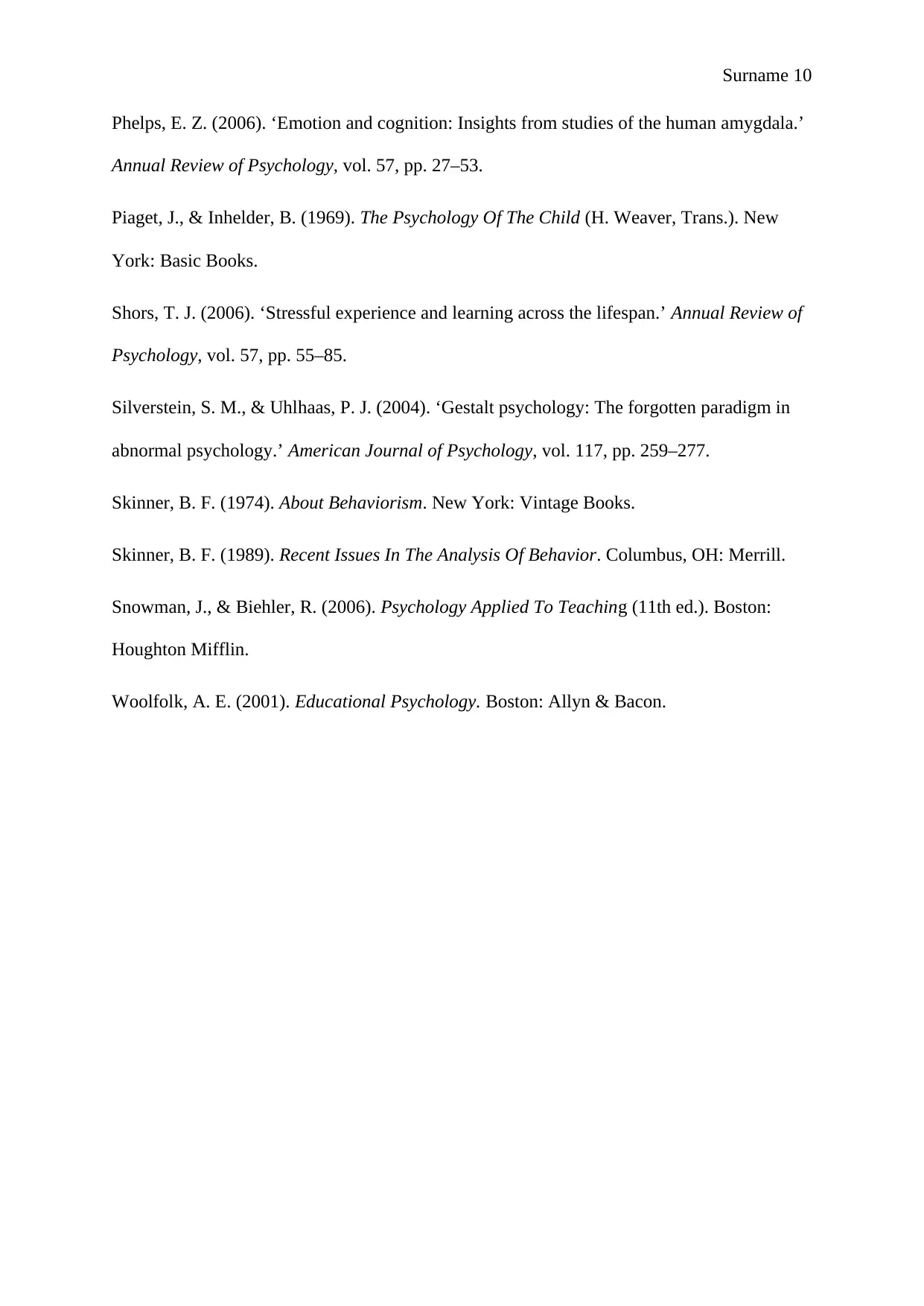
Surname 10
Phelps, E. Z. (2006). ‘Emotion and cognition: Insights from studies of the human amygdala.’
Annual Review of Psychology, vol. 57, pp. 27–53.
Piaget, J., & Inhelder, B. (1969). The Psychology Of The Child (H. Weaver, Trans.). New
York: Basic Books.
Shors, T. J. (2006). ‘Stressful experience and learning across the lifespan.’ Annual Review of
Psychology, vol. 57, pp. 55–85.
Silverstein, S. M., & Uhlhaas, P. J. (2004). ‘Gestalt psychology: The forgotten paradigm in
abnormal psychology.’ American Journal of Psychology, vol. 117, pp. 259–277.
Skinner, B. F. (1974). About Behaviorism. New York: Vintage Books.
Skinner, B. F. (1989). Recent Issues In The Analysis Of Behavior. Columbus, OH: Merrill.
Snowman, J., & Biehler, R. (2006). Psychology Applied To Teaching (11th ed.). Boston:
Houghton Mifflin.
Woolfolk, A. E. (2001). Educational Psychology. Boston: Allyn & Bacon.
Phelps, E. Z. (2006). ‘Emotion and cognition: Insights from studies of the human amygdala.’
Annual Review of Psychology, vol. 57, pp. 27–53.
Piaget, J., & Inhelder, B. (1969). The Psychology Of The Child (H. Weaver, Trans.). New
York: Basic Books.
Shors, T. J. (2006). ‘Stressful experience and learning across the lifespan.’ Annual Review of
Psychology, vol. 57, pp. 55–85.
Silverstein, S. M., & Uhlhaas, P. J. (2004). ‘Gestalt psychology: The forgotten paradigm in
abnormal psychology.’ American Journal of Psychology, vol. 117, pp. 259–277.
Skinner, B. F. (1974). About Behaviorism. New York: Vintage Books.
Skinner, B. F. (1989). Recent Issues In The Analysis Of Behavior. Columbus, OH: Merrill.
Snowman, J., & Biehler, R. (2006). Psychology Applied To Teaching (11th ed.). Boston:
Houghton Mifflin.
Woolfolk, A. E. (2001). Educational Psychology. Boston: Allyn & Bacon.
1 out of 10
Related Documents
Your All-in-One AI-Powered Toolkit for Academic Success.
+13062052269
info@desklib.com
Available 24*7 on WhatsApp / Email
![[object Object]](/_next/static/media/star-bottom.7253800d.svg)
Unlock your academic potential
Copyright © 2020–2025 A2Z Services. All Rights Reserved. Developed and managed by ZUCOL.





